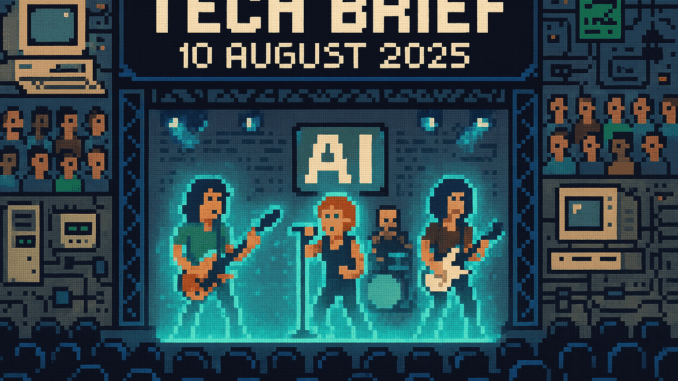
Tech Brief 10 August 2025 enters with a chorus of tough questions, live wires, and national pride. Today’s selection features resurrected icons, AI’s power appetite, Welsh ingenuity in tech, and a lunar milestone. If it sounds like a mix tape with a bent pin, that’s on purpose.
Missed yesterday’s Tech Brief? Catch up here before diving in.
Deathbots Divide Fans After AI Concert Surprises
“Is this tribute or trickery?” That’s the debate after AI-generated avatars of late rock icons appeared on stage with Rod Stewart, including an uncanny digital Ozzy Osbourne. Some fans called it a heartfelt salute. Others, especially those who felt the sting of genuine loss in the analogue age, said it felt hollow or even disrespectful.
The backlash didn’t just come from music lovers. Digital legacy campaigns warn that automating a person’s likeness risks cheapening memory and muddying the ethics of digital bereavement. Forums remembered the first VHS video walls and wondered if this has all gone too far. Is tech closing gaps, or just opening up new ones we never expected? Like watching a simulation on your dad’s old Amiga, some things can be too convincing for comfort.
OpenAI Refuses Energy Transparency for GPT-5
A single GPT-5 prompt may use as much electricity as a 40-minute bulb session. That fact, flagged by watchdogs, is hard to ignore. OpenAI refuses to disclose exactly how much energy powers its new model, even as internal analysis and external pressure mount.
Not long ago, 8-bit computers ran all week with less energy than modern cloud services burn in a second. Every line of assembly code on a Spectrum or BBC Micro was crafted for efficiency; waste was practically impossible. Fast-forward to today, where algorithmic complexity often trumps clarity about what it actually costs. Users and green campaigners alike are calling for proper disclosure.
As with deathbots, the opaque nature of modern tech can leave end users feeling out of step with the very future they helped shape.
Welsh Tech Talent Celebrated at National Eisteddfod
Wrexham played host to a proud moment: the National Eisteddfod 2025 honoured science and technology medal winners, shining a light on Welsh engineering outside the usual London circuit.
Welsh regional innovation is no footnote. During the micro boom, community computer clubs across Wales tinkered with Ataris and Dragons, crafting solutions on shoestring budgets and raw enthusiasm. Today’s winners inherit that scrappy, collaborative spirit. The ceremony doubled as a reminder, maybe even a rebuke, that Silicon Valley isn’t the only place setting standards or nurturing talent.
For a region sometimes sidelined, community memory and nerdy camaraderie bring national history into the digital era. It matters. If you’re building, repairing, or just dreaming in Welsh, the Eisteddfod says you belong.
From the Wayback Machine
On This Day: 1966: Lunar Orbiter 1 Launches From Cape Canaveral
On 10 August 1966, NASA’s Lunar Orbiter 1 blasted off, later becoming the first American craft to orbit the Moon. Measuring 1.65 metres tall, it combined off-the-shelf film technology and cold-war urgency to transmit over 200 lunar photographs. Kodak’s imaging system, engineered for military satellites, gave Apollo’s planners their first practical lunar maps. The project’s blend of real-time improvisation and careful redundancy would ring true for anyone who’s fixed a BBC Micro with only spare cable and optimism. Some legacies, it seems, are built in the dark, against the odds.
Today’s Big Question
Do digital resurrection, power-hungry AI, and grassroots tech all point to the same thing: a longing for connection? Tech Brief 10 August 2025 leaves that open, but invites a more direct conversation. Are we trading real roots for manufactured magic, and what would you fix if you could?
Stay curious, tinker kindly, never trust a smooth keyboard. Clive would scold you for that anyway.
Missed yesterday’s Tech Brief? Catch up here

Leave a Reply